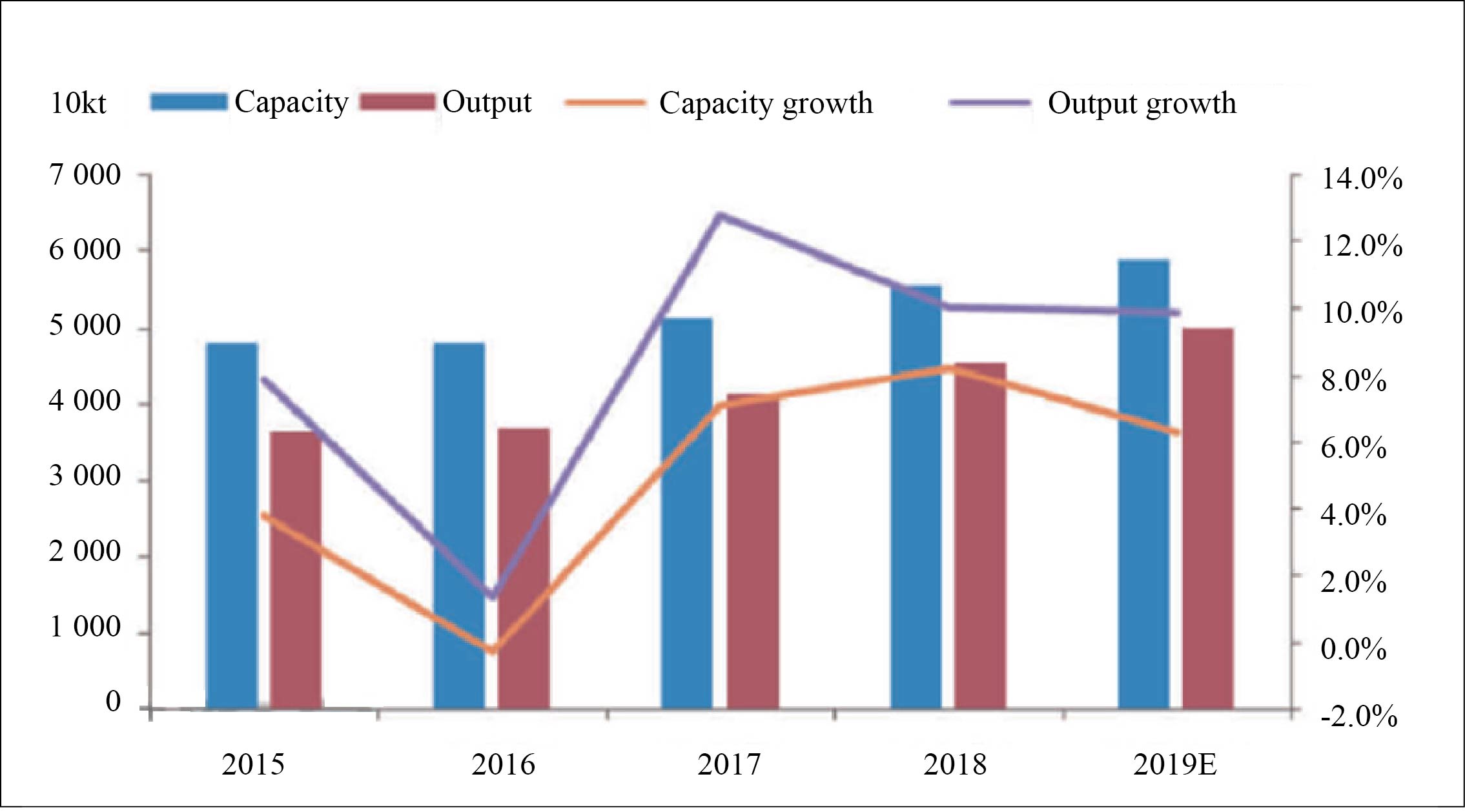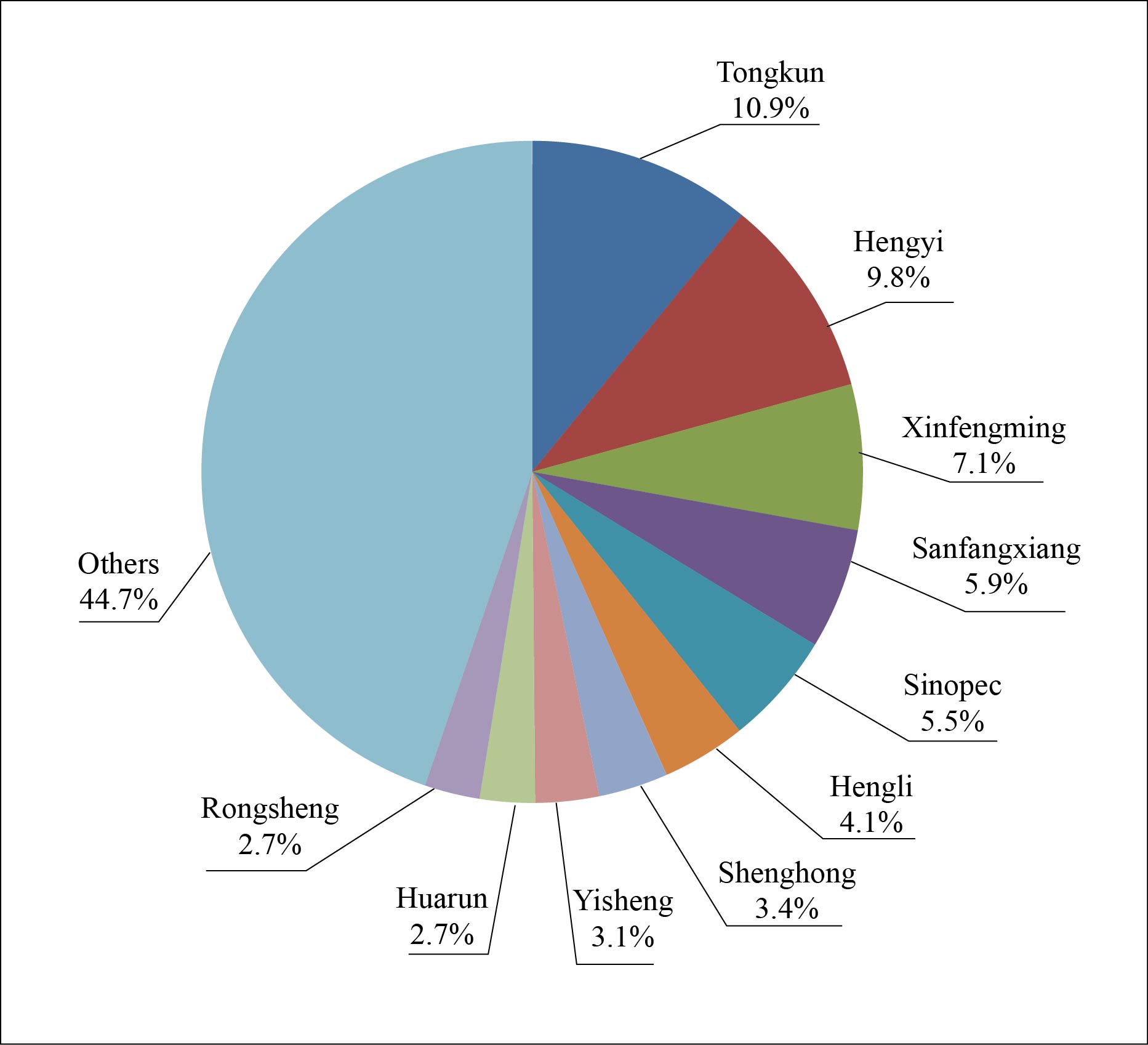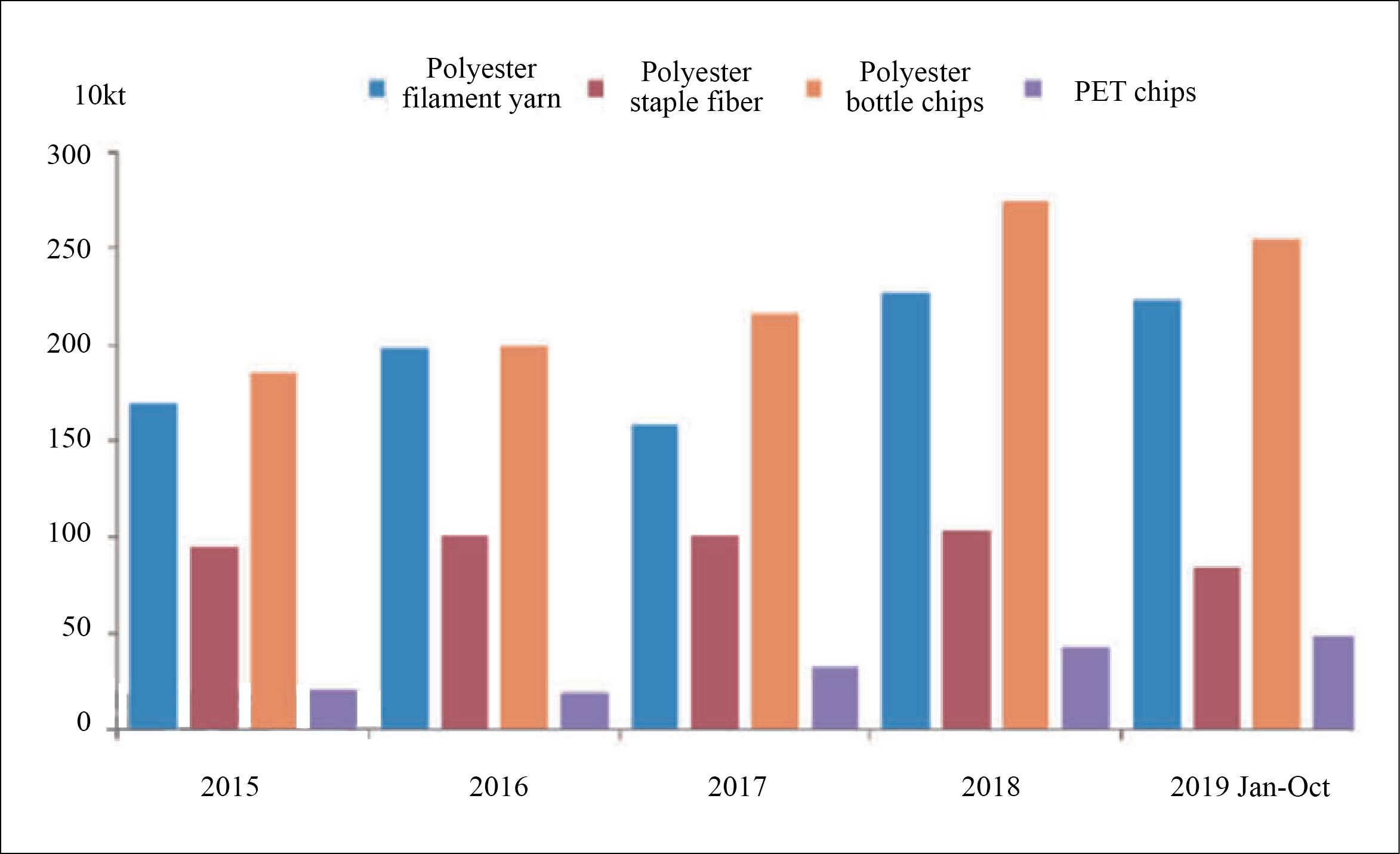By Zhu Yaqiong, Ma Qi, Oilchem China
Polyester capacity expansion slackens while the production growth remains high
Unlike the substantial capacity expansion of its raw material PX and PTA, China’s polyester capacity expansion has always been in a mild trend. By the end of 2019, a total of 19 new polyester units have been launched, with the new capacity at 3.59 million t/a and total capacity at 58.89 million t/a. The growth has slowed down to around 6.3% compared to late 2018. See Chart 1 for the detailed domestic polyester capacities and outputs from 2015 to 2019.

Chart 1 China’s polyester capacities and outputs, 2015-2019
The sluggish downstream demand, coupled with the decline in product profits, decreased the operating rate of polyester industry in 2019 over 2018. But, due to the commissioning of 3.59 million tons’ new capacities in the year, China’s polyester output in 2019 still showed rapid growth, reaching 49.98 million tons, up nearly 10% from 2018. See Table 1 for new polyester capacities in 2019.
Table 1 China’s new polyester capacities in 2019
Producer | New capacity (kta) | Launching time | Product |
Yangzhou Fuwei’er | 100 | Feb, 2019 | Lowmelt PET |
Guangdong Shuye | 60 | Feb, 2019 | PET chips |
Fujian Jinwei Newfiber | 200 | Mar, 2019 | Polyester filament yarn |
Lixin Huaxian | 100 | Mar, 2019 | Polyester filament yarn |
Zhejiang HALEAD | 200 | Mar, 2019 | PET chips |
Jiaxing Yipeng | 250 | Apr, 2019 | Polyester filament yarn |
Jiangsu Xiangyang | 80 | Apr, 2019 | Polyester staple fiber |
Xin Feng Ming Zhongyue Phase I | 300 | Jul, 2019 | Polyester filament yarn |
Jiangsu Shuang Xing Caisu | 100 | Jul, 2019 | PET chips |
TongKun Hengbang Phase IV | 300 | Aug, 2019 | Polyester filament yarn |
TongKun Hengyou | 600 | Aug, 2019 | Polyester filament yarn |
TongKun Hengteng Phase IV | 300 | Sep, 2019 | Polyester filament yarn |
Xin Feng Ming Zhongyue Phase II | 300 | Oct, 2019 | Polyester filament yarn |
Yangzhou Fuwei’er | 50 | Oct, 2019 | LowMelt polyester staple fiber |
Dalian Yisheng | 350 | Nov, 2019 | PET chips |
Shanghai Warburg Chemical Fiber | 100 | Nov, 2019 | Polyester filament yarn |
Anhui Jinzhai Xinlun | 100 | Dec, 2019 | Polyester staple fiber |
Nantong Hengke | 100 | Dec, 2019 | Polyester filament yarn |
Total | 3 590 |
Industry concentration keeps increasing
In 2019, the domestic polyester industry gained another 3.59 million t/a capacity, and most of the new capacities were from major players such as Tongkun, Hengyi and Xinfengming. The top ten producers had 2.4 million t/a of new capacities during the year, accounting for nearly 70% of the total new capacities in 2019. The concentration of the polyester industry has continued to increase. The concentration of CR10 in the domestic polyester industry in 2019 is shown in Chart 2.

Chart 2 China’s polyester industry CR10 concentration in 2019
By now, the CR10 concentration has been as high as 55.3% in polyester filament yarn sector, up 0.8% over 2018.
Tax cuts boost enterprises’ confidence
At the beginning of 2019, the Ministry of Finance, the State Administration of Taxation, and the General Administration of Customs jointly released news on the value-added tax reform. From April 1, 2019, the value-added tax rate has been adjusted for the general value-added taxpayers (hereinafter referred to as taxpayers) with taxable sales or imports. For the original tax rate of 16%, the tax was adjusted to 13%; for the original 10% tax rate, the tax rate was adjusted to 9%, coupled with expanded deductions, additional deductions and rebates, which is a major benefit for enterprises. Polyester market confidence was boosted, more enquiries from downstream were seen, and production and sales increased significantly.
Great export situation
The export data of polyester products from 2015 to 2019 is shown in Chart 3. In 2019, the export volume increased significantly compared with previous years. From January to October, the export volume of polyester products (polyester filament yarn, polyester staple fiber, polyester bottle chips, PET chips) exceeded 6 million tons. The increase of polyester filament yarn was particularly extraordinary, surging by nearly 20% in the first 10 months compared with the same period in 2018.

Chart 3 Exports of polyester products, 2015-2019
Textile industry structure adjustment & industrial upgrade
In order to optimize the regional layout and promote the structural adjustment and industrial upgrading of the textile industry, the Ministry of Industry and Information Technology issued relevant documents to promote the transfer of the textile industry. There are three main directions for the textile industry: transfer within the province to achieve a "win-win" result; transfer to the central and western regions to take into account both exports and domestic demand; transfer to overseas for some enterprises with competitive edges. Per capita GDP in eastern China is now close to US$5 000, but in the central and western regions it is only about US$2 000. So, there is still a lot of room for the central and western regions to accept industries from the east.
At present, nearly 1 000 Chinese textile companies have invested to build factories in Vietnam and Cambodia, and more than 100 have done the same thing in Bangladesh. These enterprises have circumvented trade barriers and reduced production costs by accelerating internationalization and transnational resource allocation.
The domestic polyester industry in 2019 exhibited three characteristics. 1) The sales promotion continued to reduce the profit of polyester products during the year; 2) the decline in profits and weak demand caused a slight decrease in operation rate; 3) drops in sales promotion and utilization led to a decline in inventory levels in polyester factories compared to previous years. This reflects to some extent that polyester products are still significantly affected by raw materials during the year. As for the future, under the background of large-scale launching of new PX and PTA capacities in 2020, the profit of the industry chain is expected to shift to polyester products, and the downstream demand in 2020 will become the fundamental reason determining the rise and fall of the polyester industry.